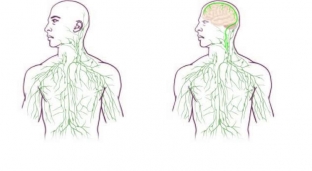Despite the fact that scientists have been studying human anatomy for thousands of years, secrets remain in the body even to this day. Until recently, they wondered if there was a connection between the brain and the lymphatic system of the body.
Lymphatic system — it is part of the vascular system in vertebrates that complements the cardiovascular system. It plays an important role in the cleansing of cells and tissues of the body, metabolism and the functioning of the immune system. It is she who is responsible for the removal of waste products of internal organs back into the blood.
However, until recently it was not possible to detect lymphatic vessels in the cerebral cortex. Its biological waste was thought to be drained through the sinuses of the dura mater. At the same time, it was not clear how his immune system should work in this case. Even modern methods like MRI did not give an answer to this question. However, a recent study by Antoine Le Vaux has forced a fresh look at this mystery.
While studying the dura mater in the laboratory, University of Virginia Health System (UAV) professor Antoine Louveau made an amazing discovery in the anatomy of the brain — membrane structure covering the brain in mice. He succeeded in creating a method of opening that allows you to keep this membrane structure intact. After the successful completion of this procedure, Professor Luvo noticed the vessels covering it, which, under close examination, turned out to be the vessels of the lymphatic system that science has long sought.
The photo on the left — traditional representation of the lymphatic system, described in textbooks. Right — current idea of her.

Doctor of Biology and Chair of the Department of Neurology at UAV University, Kevin Lee, describes his reaction to the discovery: "When I first saw the results of the guys' work, all I had to say was: "We'll have to rewrite all the textbooks on up to this point, the central nervous system had never had a known lymphatic system. However, the results of the work, which were then confirmed many times, it became obvious that they would radically change people's ideas about how the central nervous system works with the immune system ".
The head of the laboratory, Jonathan Kipnis, was at first very skeptical: "I could not even imagine that previously unknown structures could be found in the body. I thought that everything had already been marked up for a long time, and that the discoveries on this subject had ended in the middle of the last century. Obviously I was wrong".
An unexpected discovery raises more questions than it answers. For example, in Alzheimer's disease, large "chunks" of proteins accumulate in the brain. According to Kipnis, this may be due to the fact that they are simply not removed from the brain with due efficiency through the lymphatic vessels.
It is already known that with age, the lymphatic vessels begin to look different. Their further close study can shed light on the cause of brain diseases and ways to treat them — from Alzheimer's and multiple sclerosis to autism.







Add a comment